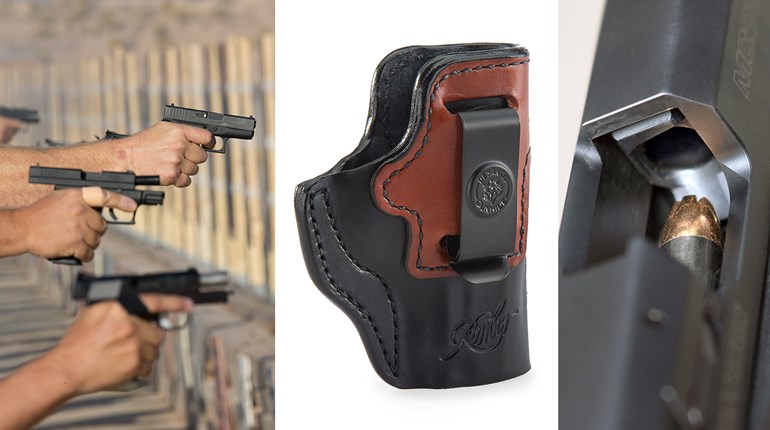
Not too long ago the addition of lasers on firearms was considered a gimmick, but today that thinking has changed. Shooters are learning the value of laser sights, which allow you to shoot more accurately in low-light conditions and from difficult positions where you simply can’t raise and aim using traditional iron sights. This widespread acceptance of laser sighting systems has led companies to offer various options for shooters, and none is more basic than the option of selecting a red or a green laser.
But that choice is not as simple as it may initially seem. To understand how lasers work, we must first understand some basic physics. Light travels in waves, part of the electromagnetic spectrum. Different wavelengths in the visible spectrum produce different colors; red light waves range from 620 to 750 nanometers, and green light ranges from 495 to 570 nanometers. The human eye is better able to recognize colors in the green spectrum, so a green laser is more visible under bright light conditions. It would seem logical, then, that all firearm lasers would be green because they are the easiest to recognize in the broadest range of ambient light conditions. But there’s a catch—building a red laser is relatively simple, requiring only a diode, optics and some basic electronics to construct. Green lasers are more complex. Building a green laser requires a special 808 diode, a second infrared laser crystal and a frequency-doubling crystal, and these parts must be carefully aligned to produce the green laser image. For this reason, green lasers are more complicated, slightly larger and more time-consuming (and thus expensive) to build. When you are purchasing a laser for your firearm there’s an inherent tradeoff. If you want a smaller, lighter, cheaper laser, red is best. If you want a laser that is more visible under a wide variety of lighting conditions, you’ll need a green laser.
“Side-by-side, a green and red laser will result in a green laser that is easier to see during bright conditions,” says LaserLyte’s Dusty Gibson. “During low light conditions both are extremely effective. Right now green is about double the price of red with similar features. There is cheaper green, but you will sacrifice brightness or battery life.”
Gibson says that new technology is allowing companies to make smaller, less expensive green lasers, but that many customers are happy with a red laser that is more affordable and more compact. The choice between the two, then, is largely a matter of personal preference and budget, and the decision is ultimately up to the consumer. If your firearm budget is limited but you still want the convenience and added benefit of a laser, then a red model should work just fine under a wide variety of lighting conditions. If you have the money and want a laser that is highly visible even in bright sunlight, then a green laser is probably a better option. No matter which laser you choose, there are many advantages to adding a laser sight to your firearm. It’s a misconception that all dangerous encounters happen in dark conditions, and most shooters primarily practice on well-lit ranges where ambient light is sufficient to use iron sights. In low-light, however, the advantage of a laser becomes quite obvious, and under those conditions both a red and green laser will provide an advantage. There are more red laser options available today than green, but demand for green lasers has prompted companies to offer more options in this color. No matter which option you choose, the addition of a laser to your personal defense firearm makes sense because it allows you to shoot accurately even under the worst conditions.







































